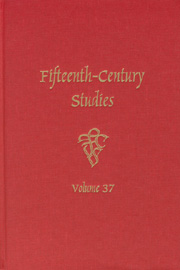Book contents
- Frontmatter
- Contents
- Essays
- Tradition and Innovation in 15th and 16th Century Popular Song Poetry: From Oswald von Wolkenstein to George Forster
- The Poet at the Mirror: René d'Anjou and Authorial Doubling in the Livre du Cœur d'Amour épris
- Modern Translator or Medieval Moralist?: William Caxton and Aesop
- A Battle of “Trechour Tung[s]”: Gaelic, Middle Scots, and the Question of Ethnicity in the Scottish Flyting
- Wheels and Wycliffites: The Role of Sacred Images in Capgrave's The Life of Saint Katherine
- Sympathy for the Devil: Gilles de Rais and His Modern Apologists
- Milieu, John Strecche, and the Gawain-Poet
- Thinking on Paper: Reference Tools, Tables, and Diagrams in Conrad Buitzruss's Compendium (Clm 671)
- Book Reviews
Milieu, John Strecche, and the Gawain-Poet
from Essays
Published online by Cambridge University Press: 05 February 2013
- Frontmatter
- Contents
- Essays
- Tradition and Innovation in 15th and 16th Century Popular Song Poetry: From Oswald von Wolkenstein to George Forster
- The Poet at the Mirror: René d'Anjou and Authorial Doubling in the Livre du Cœur d'Amour épris
- Modern Translator or Medieval Moralist?: William Caxton and Aesop
- A Battle of “Trechour Tung[s]”: Gaelic, Middle Scots, and the Question of Ethnicity in the Scottish Flyting
- Wheels and Wycliffites: The Role of Sacred Images in Capgrave's The Life of Saint Katherine
- Sympathy for the Devil: Gilles de Rais and His Modern Apologists
- Milieu, John Strecche, and the Gawain-Poet
- Thinking on Paper: Reference Tools, Tables, and Diagrams in Conrad Buitzruss's Compendium (Clm 671)
- Book Reviews
Summary
The Gawain-poet's contributions to English language and literature were seminal and his quality as a poet maintains its excellence after more than 600 years. Yet the Gawain-poet continues to be anonymous. His most widely read work, Sir Gawain and the Green Knight (SGGK), is still a mystery, for readers and scholars have yet to understand its many references to places and issues outside the text. The artist's craft and sophistication go underappreciated when much of the humor, irony, and metaphor in SGGK depends upon knowing the context and audience to which the poet's allusions apply. The goal of this study is to open the field to new knowledge of the Gawainpoet and the milieu of SGGK. One premise is that Gawain-poet studies have been inhibited by some conventional habits of mind that limit the range for research in spite of expanding numbers of studies, easier access to transcriptions, growing numbers of translations, digital imaging of texts and illuminations, linguistic analyses, and developments in dialectology. There are four common assumptions in the field of Gawain-studies which are especially persistent and problematic.
Chief among these issues is a dating premise represented by an often-quoted statement published in 1925 by John R. R. Tolkien and Eric V. Gordon. The conjecture placed SGGK in “the last quarter of the fourteenth century, the latest possible date being determined by that of the manuscript, c.1400.” The second complication is the persistent dismissal of a message written over the illumination which appears on folio 129.
- Type
- Chapter
- Information
- Fifteenth-Century Studies 37 , pp. 139 - 200Publisher: Boydell & BrewerPrint publication year: 2012



